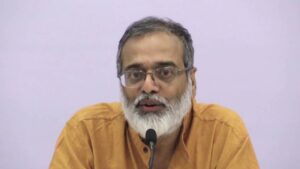
Noam Chomsky – Photo: YouTube
Russia’s war in Ukraine has gone on for nearly nine months, and it has now escalated to highly lethal levels. Putin is targeting Ukraine’s energy infrastructure and has repeatedly raised the specter of nuclear weapons. The Ukrainians, on the other hand, continue to believe that they can defeat the Russians on the battlefield and even retake Crimea. Indeed, the war in Ukraine has no endgame in sight. As Noam Chomsky points out in the exclusive interview for Truthout that follows, the escalation of the conflict has pushed diplomatic options even further into the background.
Chomsky is institute professor emeritus in the department of linguistics and philosophy at MIT and laureate professor of linguistics and Agnese Nelms Haury Chair in the Program in Environment and Social Justice at the University of Arizona. One of the world’s most-cited scholars and a public intellectual regarded by millions of people as a national and international treasure, Chomsky has published more than 150 books in linguistics, political and social thought, political economy, media studies, U.S. foreign policy and world affairs. His latest books are The Secrets of Words (with Andrea Moro; MIT Press, 2022); The Withdrawal: Iraq, Libya, Afghanistan, and the Fragility of U.S. Power (with Vijay Prashad; The New Press, 2022); and The Precipice: Neoliberalism, the Pandemic and the Urgent Need for Social Change (with C.J. Polychroniou; Haymarket Books, 2021).
C.J. Polychroniou: Noam, the war in Ukraine nears its ninth month mark and, instead of de-escalation, it is heading toward “uncontrolled escalation.” In fact, it’s becoming a war without end as Russia has been targeting Ukraine’s energy infrastructure over the last few weeks and stepping up its strikes in the eastern region of the country, while the Ukrainians keep asking for more and more weapons from the west as they believe that they have the potential to defeat Russia on the battlefield. As things stand at the present juncture, can diplomacy end the war? Indeed, how do you de-escalate a conflict when the escalation level is so high, and the warring sides seem to be unable to reach a joint decision about the issues of conflict between them? For example, Russia will never accept rolling back borders to the position they were before February 24, when the invasion was launched.
Noam Chomsky: Tragedy foretold. Let’s briefly look back at what we’ve been discussing for months.
Prior to Putin’s invasion there were options based generally on the Minsk agreements that might well have averted the crime. There is unresolved debate about whether Ukraine accepted these agreements. At least verbally, Russia appears to have done so up until not long before the invasion. The U.S. dismissed them in favor of integrating Ukraine into the NATO (that is, U.S.) military command, also refusing to take any Russian security concerns into consideration, as conceded. These moves were accelerated under Biden. Could diplomacy have succeeded in averting the tragedy? There was only one way to find out: Try. The option was ignored.
Putin rejected French president Macron’s efforts, to almost the last minute, to offer a viable alternative to aggression. Rejected them at the end with contempt — also shooting himself and Russia in the foot by driving Europe deep into Washington’s pocket, its fondest dream. The crime of aggression was compounded with the crime of foolishness, from his own point of view.
Ukraine-Russia negotiations took place under Turkish auspices as recently as March-April. They failed. The U.S. and U.K. opposed them. Due to lack of inquiry, part of the general disparagement of diplomacy in mainstream circles, we don’t know to what extent that was a factor in their collapse.
Washington initially expected Russia to conquer Ukraine in a few days and was preparing a government-in-exile. Military analysts were surprised by Russian military incompetence, remarkable Ukrainian resistance, and the fact that Russia didn’t follow the expected U.S.-U.K. model (also the model followed by Israel in defenseless Gaza) of war: go at once for the jugular, using conventional weapons to destroy communications, transportation, energy, whatever keeps the society functioning.
The U.S. then made a fateful decision: Continue the war to severely weaken Russia, hence avoiding negotiations and making a ghastly gamble: that Putin will pack up his bags and slink away in defeat to oblivion if not worse, and will not use the conventional weapons which, it was agreed, he had, to destroy Ukraine.
If Ukrainians want to risk the gamble, that’s their business. The U.S. role is our business.
Now Putin has moved on to the anticipated escalation, “targeting Ukraine’s energy infrastructure over the last few weeks and stepping up its strikes in the eastern region of the country.” Putin’s escalation to the U.S.-U.K.-Israel model has been rightly condemned for its brutality — condemned by those who have accepted the original with little if any objection, and whose ghastly gamble laid the groundwork for the escalation, exactly as was warned throughout. There will be no accountability, though some lessons may have been learned.
While very mild liberal calls for considering a diplomatic option alongside of full support for Ukraine are at once subjected to a torrent of vilification, and sometimes quickly withdrawn in fear, voices calling for diplomacy from the mainstream establishment are exempted from this treatment, including voices from the major establishment journal Foreign Affairs. It may be that such concerns over a destructive war, with increasingly ominous potential consequences, are reaching the neocon war hawks who seem to be driving Biden’s foreign policy. So some of their recent statements indicate.
Quite possibly they are hearing other voices too. While U.S. energy and military corporations are laughing all the way to the bank, Europe is being badly hit by the cutoff of Russian supplies and the U.S.-initiated sanctions. That’s particularly true for the German industrial complex that is the base of the European economy. It remains an open question whether European leaders will be willing to supervise Europe’s economic decline and increased subordination to the U.S., and whether their populations will tolerate these outcomes of adhering to U.S. demands.
The most dramatic hit to the European economy is the loss of cheap Russian gas, now partially replaced by far more expensive American supplies (also greatly increasing pollution in transit and distribution). That is, however, not all. Russian supplies of minerals play an essential role in Europe’s industrial economy, including efforts to move to renewable energy.
The future of gas supplies to Europe was severely undermined, perhaps permanently, with the sabotage of the Nord Stream pipelines linking Russia and Germany through the Baltic Sea. This is a major blow to both countries. It was enthusiastically welcomed by the U.S., which had been trying for years to prevent this project. Secretary of State [Antony] Blinken described the destruction of the pipelines as “a tremendous opportunity to once and for all remove the dependence on Russian energy and thus to take away from Vladimir Putin the weaponization of energy as a means of advancing his imperial designs.”
The strong U.S. efforts to block Nord Stream long preceded the Ukraine crisis and the current fevered constructions about Putin’s long-term imperial designs. They go back to the days when Bush II was looking into Putin’s eyes and perceiving that his soul was good.
President Biden informed Germany that if Russia were to invade Ukraine, “then there will be no longer a Nord Stream 2. We will bring an end to it.”
One of the most important events of recent months, the sabotage was quickly dispatched to obscurity. Germany, Denmark and Sweden have conducted investigations of the sabotage in their nearby waters but are keeping silent about the results. There is one country that certainly had the capability and motive to destroy the pipelines. That is unmentionable in polite society. We can leave it at that.
Is there still an opportunity for the kind of diplomatic efforts that mainstream establishment voices are calling for? We cannot be sure. As the conflict has escalated, the options for diplomacy have declined. At the very least, the U.S. could withdraw its insistence on sustaining the war to weaken Russia, thus barring the way to diplomacy. A stronger position is that of the establishment voices cited: calls for diplomatic options to be explored before the horrors become even worse, not only for Ukraine but far beyond.
Ukrainian officials claim they have a strategy in place to take back Crimea because it was illegally annexed by Moscow in 2014. Similar announcements had been made even before Russia’s invasion of Ukraine. While no military strategist believes that Ukraine is in a position to retake Crimea, isn’t this further evidence that there is no endgame in sight for the Russia-Ukraine war? Isn’t this indeed another reason why the long-range ATACMS weapons that Ukraine says it needs should not be delivered to them?
The Biden administration and the Pentagon have been careful to limit the massive flow of weapons to those that are not likely to lead to a NATO-Russian war, which would be effectively terminal for all. Whether these delicate matters can be kept under control, no one can be sure. All the more reason to try to bring the horrors to an end as soon as possible.
China has warned Russia against threats to use nuclear weapons in the war against Ukraine. Is this a sign that Beijing may be thinking of distancing itself from Putin’s military adventures in Ukraine? In either case, it indicates that there are limits to the friendship between China and Russia, doesn’t it?
There is little evidence, to my knowledge, of China distancing itself from Russia. It seems, rather, that their relations are becoming closer in common opposition to the entrenchment of a U.S.-run unipolar world, sentiments shared in most of the world. China surely opposes the use of nuclear weapons, as does anyone with a shred of sanity remaining. And like almost all the world, it wants a quick settlement of the conflict.
Talk of nuclear weapons has been mostly in the West. Russia has reiterated the universal position of nuclear states: that they might resort to nuclear weapons in the event of a threat to survival. That stand became more dangerous when Putin annexed parts of Ukraine, extending the universal doctrine to a broader territory.
It’s not quite true that the doctrine is universal. The U.S. has a far more extreme position, framed before the invasion of Ukraine but announced only recently: a new nuclear strategy that the Arms Control Association described as “a significant expansion of the original mission of these weapons, namely deterring existential threats against the United States.”
The significant expansion is spelled out by Admiral Charles Richard, head of the U.S. Strategic Command (STRATCOM). Under the newly announced Nuclear Posture Review, nuclear weapons provide the “maneuver space” necessary for the United States “to project conventional military power strategically.” Nuclear deterrence is therefore a cover for conventional military operations around the globe, deterring others from interfering with U.S. conventional military operations. Nuclear weapons thus “deter all countries, all the time” from interfering with U.S. actions, Admiral Richard continued.
Stephen Young, senior Washington representative at the Union of Concerned Scientists, described the new Nuclear Posture Review as “a terrifying document [that] not only keeps the world on a path of increasing nuclear risk, in many ways it increases that risk,” already intolerably high.
A fair assessment.
The press scarcely reported on the Nuclear Posture Review, describing it as not much of a change. They happen to be right, but for reasons of which they are evidently unaware. As STRATCOM commander Richard could doubtless inform them, that has been U.S. policy since 1995, when it was elaborated in a STRATCOM document titled “Essentials of Post-Cold War Deterrence”. Under Clinton, nuclear weapons must be constantly available because they “cast a shadow” over conventional use of force, deterring others from interfering. As Daniel Ellsberg put it, nuclear weapons are constantly used, just as a gun is used in a robbery even if it is not fired.
The 1995 STRATCOM document goes on to call for the U.S. to project a “national persona” of “irrationality and vindictiveness,” with some elements “out of control.” That will frighten those who might have thoughts of interfering. It is the “madman doctrine” attributed to Nixon on thin evidence, but now in an official document.
All of this is within the framework of the overarching Clinton doctrine that the U.S. must be ready to resort to force multilaterally if we can, unilaterally if we must, to ensure “uninhibited access to key markets, energy supplies and strategic resources.”
It is, then, true that the new doctrine is not very new, though Americans are unaware of the facts — not because of censorship. The documents have been public for decades and quoted in critical literature that is kept to the margins.
It should be of great concern that talk of nuclear war is being bandied about casually as a possibility to be considered. It is not. It is most definitely not.
Source: https://truthout.org/articles/chomsky-options-for-diplomacy-decline-as-russias-war-on-ukraine-escalates/
C.J. Polychroniou is a political scientist/political economist, author, and journalist who has taught and worked in numerous universities and research centers in Europe and the United States. Currently, his main research interests are in U.S. politics and the political economy of the United States, European economic integration, globalization, climate change and environmental economics, and the deconstruction of neoliberalism’s politico-economic project. He is a regular contributor to Truthout as well as a member of Truthout’s Public Intellectual Project. He has published scores of books and over 1,000 articles which have appeared in a variety of journals, magazines, newspapers and popular news websites. Many of his publications have been translated into a multitude of different languages, including Arabic, Chinese, Croatian, Dutch, French, German, Greek, Italian, Japanese, Portuguese, Russian, Spanish and Turkish. His latest books are Optimism Over Despair: Noam Chomsky On Capitalism, Empire, and Social Change (2017); Climate Crisis and the Global Green New Deal: The Political Economy of Saving the Planet (with Noam Chomsky and Robert Pollin as primary authors, 2020); The Precipice: Neoliberalism, the Pandemic, and the Urgent Need for Radical Change (an anthology of interviews with Noam Chomsky, 2021); and Economics and the Left: Interviews with Progressive Economists (2021).





